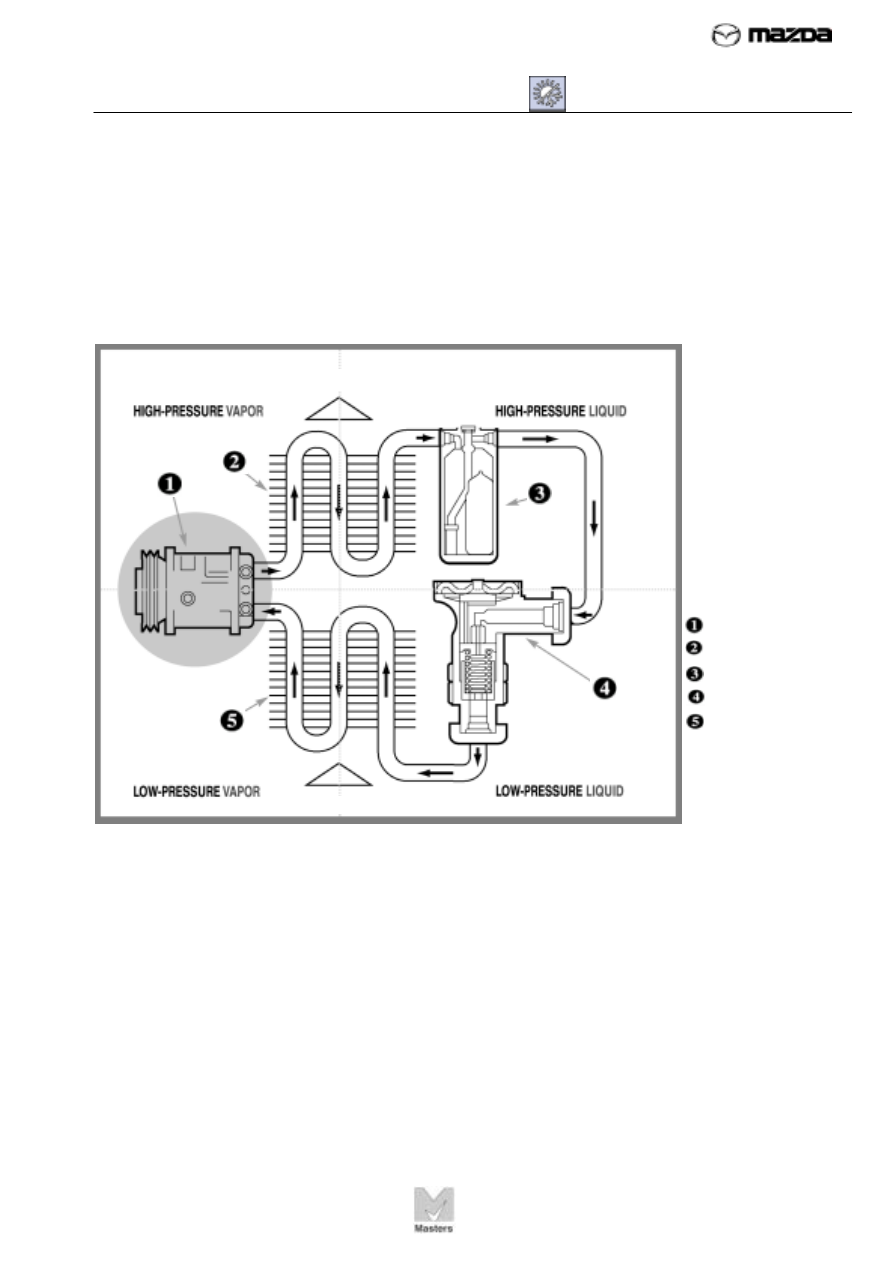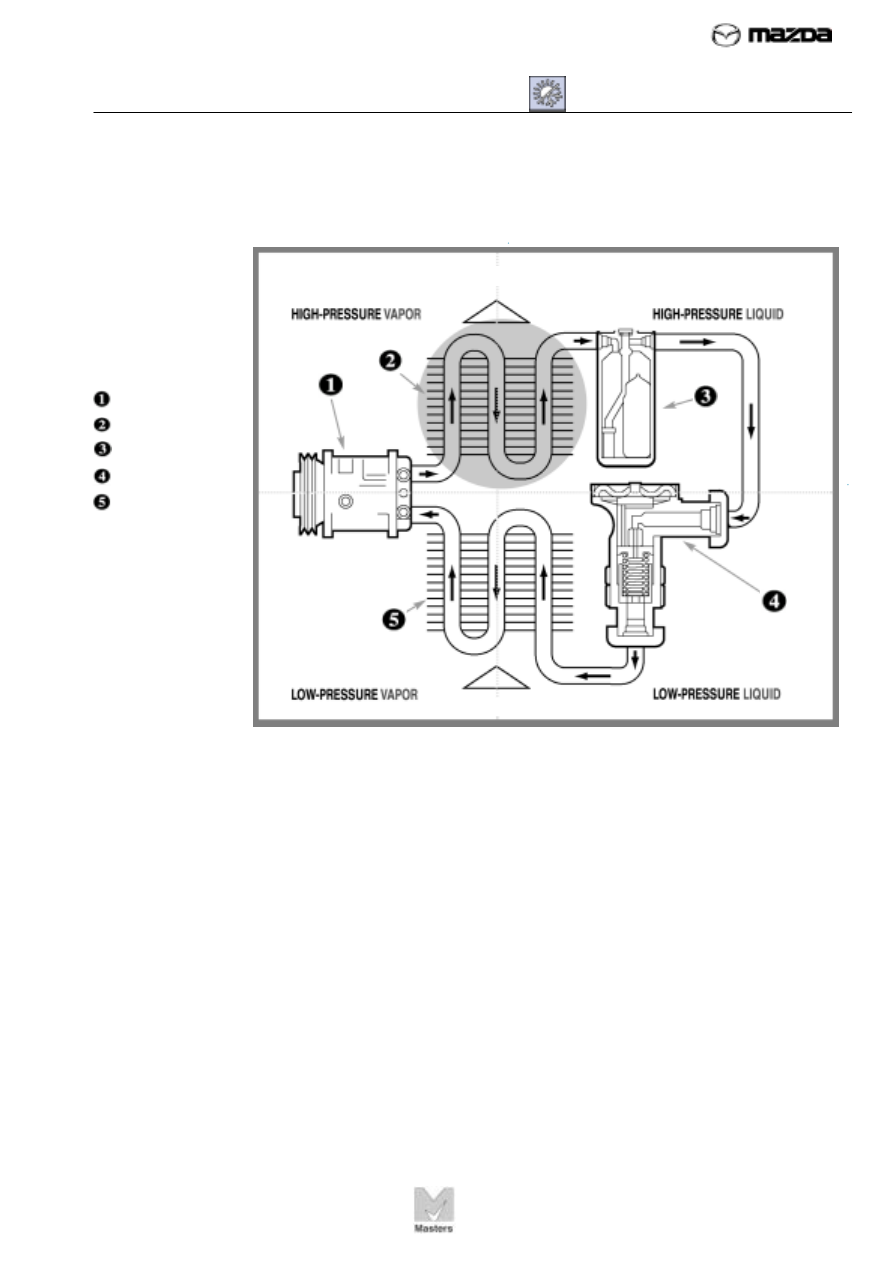Mazda Training manual — part 267

Air Conditioning Fundamentals
TC070-05-01S
6 – REFRIGERATION
CYCLE
42
High Pressure
We will begin the refrigeration cycle at the compressor, located on the
left side of Figure 23.The compressor draws in low-pressure vapor
(about 30 psi) from the evaporator and compresses it to about 175 psi.
A drive belt on the engine turns the compressor pulley, which spins the
compressor when its magnetic clutch is engaged. The system monitors
refrigerant pressure and activates the compressor only when needed.
The compressor pushes this vapor through the outlet to the condenser.
(The expansion valve is the “plug” in the circuit that allows pressure to
build on the high-pressure side of the system.) This hot, high-pressure
vapor carries heat picked up in the evaporator, as well as additional
heat from the increased pressure provided by the compressor. At this
point, the refrigerant may be as hot as 130° F (54° C).
FIGURE 23 The
compressor draws
in warm,
low-pressure vapor
from the evaporator
and pushes out
highly compressed,
hot vapor. Pressure
on the “high side”
remains elevated
because the
expansion valve
restricts flow in the
circuit.
Compressor
Condenser
Receiver/ dryer
Expansion valve
Evaporator
HEAT
HEAT

Air Conditioning Fundamentals
TC070-05-01S
6 – REFRIGERATION
CYCLE
43
FIGURE 24. The hot,
high- pressure vapor
entering the
condenser quickly
cools and turns to
liquid, releasing
latent heat of
condensation.
Compressor
Condenser
Receiver/ dryer
Expansion valve
Evaporator
Condensation
The hot, high-pressure vapor from the compressor next enters the
condenser, as shown in Figure 24.
The refrigerant is now under high pressure (about 175 psi), so its
boiling point is also higher. In addition, the difference between the
temperature of the outside air and the refrigerant is great, so the
refrigerant will quickly release heat to the air flowing over the surface of
the condenser. The hot gas (approximately 130° F [54° C]) quickly
cools below its high boiling point. As the vapor condenses to a liquid, it
releases large amounts of heat (latent heat of condensation).
HEAT
HEAT

Air Conditioning Fundamentals
TC070-05-01S
6 – REFRIGERATION
CYCLE
44
Airflow across the condenser may decrease when the vehicle is not
moving or in stop-and-go traffic. To compensate, most A/C systems
include an electric fan to supply additional airflow when needed.
Pressure Reduction
After flowing through the receiver/dryer, which removes moisture and
contaminants, the liquid refrigerant next enters the expansion valve, as
shown in Figure 25.
The expansion valve restricts the flow of refrigerant, allowing only a
small amount to pass through on its way to the evaporator. Refrigerant
pressure on the high side of the expansion valve can be as high as 250
psi or more. The expansion valve reduces that pressure to about 30 psi
on the low side.
FIGURE 25. The
expansion valve
restricts the flow of
refrigerant,
decreasing its
pressure,
temperature, and
boiling point.
Compressor
Condenser
Receiver/ dryer
Expansion valve
Evaporator
HEAT
HEAT

Air Conditioning Fundamentals
TC070-05-01S
6 – REFRIGERATION
CYCLE
45
FIGURE 26. In the
evaporator, the
refrigerant picks up
heat from the
passenger
compartment and
changes into a
low-pressure vapor.
The compressor
draws in this warm
vapor and
compresses it to
begin the
refrigeration cycle.
Compressor
Condenser
Receiver/ dryer
Expansion valve
Evaporator
At this low pressure, the temperature of the liquid refrigerant drops from
about 130° F (54° C) to about 30° F (-1° C), and its boiling point
decreases.
As the refrigerant passes through the expansion valve, it is atomized, or
turned into a fine, liquid mist. This process increases the surface area of
the refrigerant so it will easily absorb heat when it passes through the
evaporator.
Evaporation
As the refrigerant flows into the evaporator (Figure 26), it is a cold,
low-pressure liquid mist.
At this low temperature (about 30° F [-1° C]), the refrigerant readily
picks up heat from the passenger compartment. A blower fan pushes
warm interior air over the evaporator, where it gives up its heat and
returns to the passenger compartment as cool air. Since the
refrigerant’s boiling point is lower, it quickly changes into a vapor,
allowing it to store large amounts of heat as latent heat of vaporization.
HEAT
HEAT

Нет комментариевНе стесняйтесь поделиться с нами вашим ценным мнением.
Текст